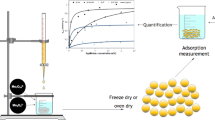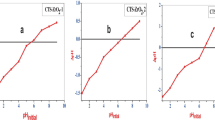Abstract
Equilibrium sorption studies of anionic species of arsenite, As(III) ions and arsenate As(V) ions onto two biosorbents, namely, chitosan and nanochitosan, have been investigated and compared. The results and trends in the sorption behavior are novel, and we have observed during the sorption process of the As(III) and As(V) on chitosan, a slow process of desorption occurred after an initial maximum adsorption capacity was achieved, before reaching a final but lower equilibrium adsorption capacity. The same desorption trend, however, is not observed on nanochitosan. The gradual desorption of As(III) and As(V) in the equilibrium sorption on chitosan is attributed to the different fractions of the dissociated forms of arsenic on the adsorbent surface and in solution and the extent of protonation of chitosan with the changing of solution pH during sorption. The change of solution pH during the sorption of arsenite ions on chitosan was also influenced by the interaction between the buffering effect of the arsenite species in the aqueous medium and the physical properties of chitosan. The final equilibrium adsorption capacity of chitosan for As(III) and As(V) was found to be around 500 and 8000 μg/g, respectively, whereas the capacities on nanochitosan are 6100 and 13,000 μg/g, respectively.






Similar content being viewed by others
References
Ahmed N, Siddiqui ZN (2015) Cerium supported chitosan as an efficient and recyclable heterogeneous catalyst for sustainable synthesis of Spiropiperidine derivatives. ACS Sustainable Chem&Eng 3:1701–1707. https://doi.org/10.1021/acssuschemeng.5b00223
Ali I, Al-Othman ZA, Alwarthan A, Asim M, Khan TA (2014) Removal of arsenic species from water by batch and column operations on bagasse fly ash. Environ Sci Pollut Res 21(5):3218–3229
Boddu VM, Abburi K, Talbott JL, Smith ED, Haasch R (2008) Removal of arsenic (III) and arsenic (V) from aqueous medium using chitosan-coated biosorbent. Water Res 42:633–642
Chen B, Hui CW, McKay G (2001) Pore-surface diffusion modelling for dyes from effluents on pith. Langmuir 17:740–748
Cheung CW, Porter JF, McKay G (2001) Removal of Cu(II) and Zn(II) ions by sorption onto bone char using batch agitation. Langmuir 18:650–656
Cheung CW, Ko DCK, Porter JF, McKay G (2003) Binary metal sorption on bone char mass transport model using IAST. Langmuir 19:4144–4153
Chaudhry SA, Ahmed M, Siddiqui SI, Ahmed S (2016) Fe(III)–Sn(IV) mixed binary oxide-coated sand preparation and its use for the removal of As(III) and As(V) from water: Application of isotherm, kinetic and thermodynamics. J Molec Liq 224(Part A):431–441
Deng S, Yu G, Xie S, Yu, Huang J, Kuwaki Y, Iseki M (2008) Enhanced adsorption of arsenate on the aminated fibers: sorption behavior and uptake mechanism. Langmuir 24:10961–10967
Dias MA, Cortez AR, Barsan MM, Santos JB, Brett CMA, de Sousa HC (2013) Development of greener multi-responsive chitosan biomaterials doped with biocompatible ammonium ionic liquids. ACS Sustain Chem Eng 1:1480–1492. https://doi.org/10.1021/sc4002577
Dogan M, Dogan AU (2007) Arsenic mineralization, source, distribution, and abundance in the Kutahya region of the western Anatolia, Turkey. Environ Geochem Health 29:119–129
Eguez EH, Cho EH (1987) Adsorption of arsenic on activated carbon. JOM 39(7):38–41
Faria PCC, Orfão JJM, Pereira MFR (2004) Adsorption of anionic and cationic dyes on activated carbons with different surface chemistries. Water Res 38:2043–2052
Gao Y, Lee K, Oshima M, Motomizu S (2000) Adsorption behavior of metal ions on cross-linked chitosan and the determination of oxoanions after pretreatment with a chitosan column. Analyt Sci 16:1303–1308
Gerente C, McKay G, Andres Y, Le Cloirec P (2005) Interactions of natural aminated polymers with different species of arsenic at low concentrations application in water treatment. Adsorption 11:859–863
Guibal E, Dambies LC, Milot CJ, Roussy J (1999) Influence of polymer structural parameters and experimental conditions on metal anion sorption by chitosan. Polym Internat 48:671–680
Habuda-Stanić M, Nujić M (2017) Arsenic removal by nanoparticles: a review. Environ Sci Pollut Res 24(3):2381–2393
Han D, Yan L (2013) Supramolecular hydrogel of chitosan in the presence of graphene oxide nanosheets as 2D cross-linkers, ACS Sustainable Chem&Eng, 1:296–300. doi: https://doi.org/10.1021/sc400352a
Hayati B, Maleki A, Najafi F, Daraei H, McKay G (2016) Synthesis and characterization of PAMAM/CNT nanocomposite as a super-capacity adsorbent for heavy metal (Ni2+, Zn2+, As3+, Co2+) removal from wastewater. J. Molec. Liq. 224, part a:1032-1040
Hering J, Chiu V (2000) Arsenic occurrence and speciation in municipal ground-water-based supply system. J Environ Eng 126(5):471–474
Jain CK, Ali I (2000) Arsenic: occurrence, toxicity and speciation techniques. Water Res 34:4304–4312
Jiang Y, Hua M, Wu B, Ma H, Pan B, Zhang Q (2014) Enhanced removal of arsenic from a highly laden industrial effluent using a combined coprecipitation/nano-adsorption process. Environ Sci Pollut Res 21(10):6729–6735
Karmacharya MS, Gupta VK, Tyagi I, Agarwal S, Jha VK (2016) Removal of As(III) and As(V) using rubber tire derived activated carbon modified with alumina composite. J. Molec. Liq. 216:836–844
Ko DCK, Tsang DHK, Porter JF, McKay (2003) Applications of multipore model for the mechanism identification during the adsorption of dye on activated carbon and bagasse pith. Langmuir 19:722–730
Kong Y, Kang J, Shen J, Chen Z, Fan L (2017) Influence of humic acid on the removal of arsenate and arsenic by ferric chloride: effects of pH, As/Fe ratio, initial As concentration, and co-existing solutes. Environ Sci Pollut Res 24(15):13295–13306
Knoerr R, Brendle J, Lebeau B, Demais H (2013) Preparation of ferric oxide modified diatomite and its application in the remediation of As(III) species from solution. Micropor Mesopor Mater 169:185–191
Kumar P, Mural S, Kumar B, Madras G, Bose B (2015) Chitosan immobilized porous polyolefin as sustainable and efficient antibacterial membranes. ACS Sustainable Chem&Eng (3):862–870
Kwok CM, McKay G (2015) Novel batch reactor design for the adsorption of arsenate on chitosan. J Chem Technol Biotechnol 85:1561–1568
Li ET, Dunn Q, Grandmaison EW, Goosen MFA (1992) Applications and properties of chitosan. J Bioact Compat Polym 7(4):370–397
Li X, Han Y, Ling Y, Wang X, Sun R (2015) Assembly of layered silicate loaded quaternized chitosan/reduced graphene oxide composites as efficient absorbents for double-stranded DNA. ACS Sustainable Chem&Eng 3:1846–1852. https://doi.org/10.1021/acssuschemeng.5b00404
Liu X, Zhang L (2015) Removal of phosphate anions using the modified chitosan beads: adsorption kinetic, isotherm and mechanism studies. Powder Technol:112–119
Lodeiro P, Kwan SM, Perez JT, Gonzalez LF, Gerente C, Andres Y, McKay G (2013) Novel Fe loaded activated carbons with tailored properties for As(V) removal: adsorption study correlated with carbon surface chemistry. Chem Eng J 215-216:105–112
Mandal BK, Ali I (2000) Occurrence, toxicity and speciation techniques. Water Res 34:4304–4312
Mima S, Miya M, Iwamoto R, Yoshikawa S (1983) Highly deacetylated chitosan and its properties. J Appl Polym Sci 28(6):1909–1917
Mondal MK, Garg R (2013) A comprehensive review on removal of arsenic using activated carbon prepared from easily available waste materials. Environ Sci Pollut Res 209(4):2670–2678
Monteiro OAC, Airoldi C (1999) Some studies of crosslinking chitosan-glutaraldehyde interaction in a homogeneous system. Int J Biol Macromol 26:119–128
Onsoyen E, Skaugrud O (1999) Metal recovery using chitosan. J Chem Tech Biotechnol 49:395–404
Pontius F, Brown KG, Chen CJ (1994) Health implications of arsenic in drinking-water. J Am Water Works Assoc 86:52–63
Podder MS, Majumder CB (2015) SD/MnFe2O4 composite, a biosorbent for As(III) and As(V) removal from wastewater: optimization and isotherm study. J. Molec. Liq. 212(2015):382–404
Qi P, Pichler T (2014) Closerlook at As(III) and As(V) adsorption onto ferrihydrite under competitive conditions. Langmuir 30:11110–11116
Ramalingam B, Motiar M, Khan R, Mondal B, Mandal AB, Das SK (2015) Facile synthesis of silver nanoparticles decorated magnetic-chitosan microsphere for efficient removal of dyes and microbial contaminants. ACS Sustainable Chem&Eng 3:2291–2302
Seco-Reigosa N, Peña-Rodríguez S, Nóvoa-Muñoz JC, Arias-Estévez M, Fernández-Sanjurjo MJ, Álvarez-Rodríguez E, Núñez-Delgado A (2014) Arsenic, chromium and mercury removal using mussel shell ash or a sludge/ashes waste mixture. Environ Sci Pollu. Res 21(5):3218–3229
Setyono T, Valiyaveettil S (2014) Chemically modified sawdust as renewable adsorbent for arsenic removal from water. ACS Sustainable Chem&Eng 2:2722–2729. https://doi.org/10.1021/sc500458x
Smedley PL, Nicolli HB, Macdonald DMJ, Barros AJ, Tullio JO (2002) Hydrogeochemistry of arsenic and other inorganic constituents in groundwaters from La Pampa, Argentina. Appl Geochem 17:259–284
Song W, Zhang M, Liang J, Han G (2015) Removal of As(V) from wastewater by chemically modified biomass. J Molec Liq 206:262–267
Thakur VK, Thakur MK (2014) Recent advances in graft copolymerization and applications of chitosan: a review. ACS Sustainable Chem&Eng 2:2637–2652. https://doi.org/10.1021/sc500634p
WHO, Guidelines for drinking water quality, health criteria and other supporting information. World Health Organization vol. 1, 1993
WHO, Guidelines for Drinking-water Quality. World Health Organization Health Criteria and Other Supporting Information World Health Organization vol.1 , 3rd edition , 2004
Wong YC, Szeto YS, Cheung WH, McKay G (2003) Equilibrium studies for acid dye adsorption onto chitosan. Langmuir 19:7888–7894
Wu FC, Tseng RL, Juang RS (1999) Role of pH in metal adsorption from aqueous solutions containing chelating agents on chitosan. Ind Eng Chem Res 38:270–275
Yazdani MR, Tuutijärvi T, Bhatnagar A, Vahala R (2016) Adsorptive removal of arsenic(V) from aqueous phase by feldspars: kinetics, mechanism, and thermodynamic aspects of adsorption. J Molec Liq 214:149–156
Nomenclature
qe Equilibrium arsenic adsorption capacity (mmol/g)
qt Arsenic adsorption capacity (mmol/g) at time (t)
m Mass of adsorbent (g)
V Volume of arsenic solution for the adsorption (L)
C0 Initial concentration of arsenic in the solution (mM)
Ce Equilibrium concentration of arsenic in the solution (mM)
pHi Initial solution pH
pHe Equilibrium solution pH
DDA Degree of deacetylation
pKa Dissociation constant
pHpzc Point of zero charge
Author information
Authors and Affiliations
Corresponding author
Additional information
Responsible editor: Guilherme L. Dotto
Rights and permissions
About this article
Cite this article
Kwok, K.C.M., Koong, L.F., Al Ansari, T. et al. Adsorption/desorption of arsenite and arsenate on chitosan and nanochitosan. Environ Sci Pollut Res 25, 14734–14742 (2018). https://doi.org/10.1007/s11356-018-1501-9
Received:
Accepted:
Published:
Issue Date:
DOI: https://doi.org/10.1007/s11356-018-1501-9




